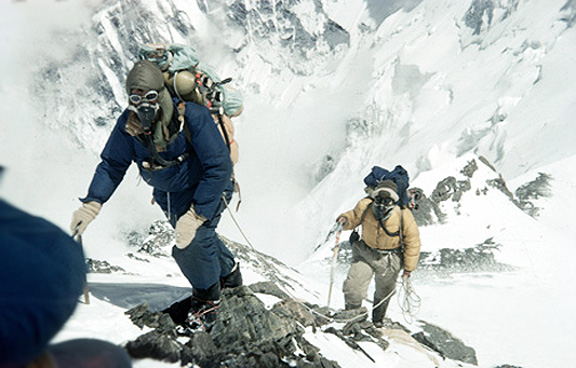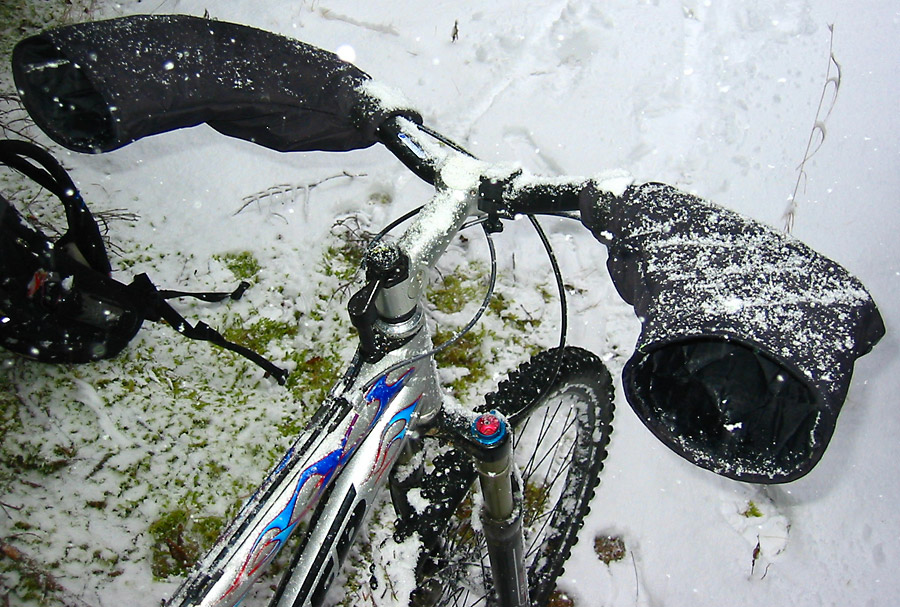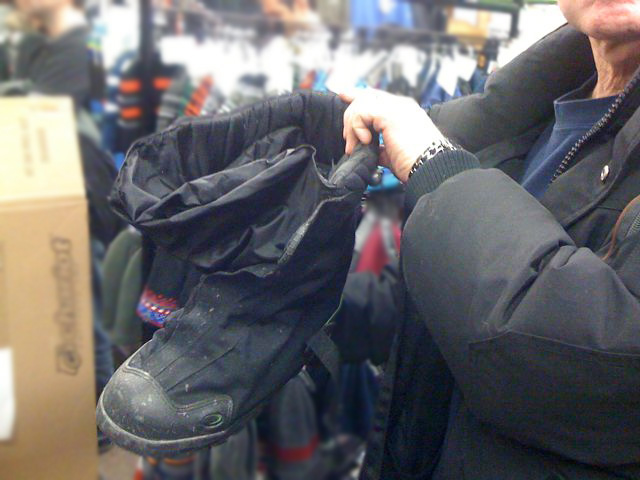Actif Epica – Lessons in Survival
 “You don’t have to be a fantastic hero to do certain things — to compete. You can be just an ordinary chap (or chick), sufficiently motivated to reach challenging goals.”
“You don’t have to be a fantastic hero to do certain things — to compete. You can be just an ordinary chap (or chick), sufficiently motivated to reach challenging goals.”
-Sir Edmund Hillary
If I learned anything at last night’s Actif Epica information session, it’s that the difference between reaching a challenging goal and winding up dead in a ditch really comes down to proper planning. The organizers (Ian Hall and the good folks at Olympia Cycle) brought together a panel of experts to help ensure participants in the 130 kilometre winter bike race are properly informed about what it will take to finish alive and smiling.
 Survival instructor and former SAR Tech Ernie Whelan started off the evening by talking about the big frozen elephant in the room: hypothermia. Hypothermia is a condition that occurs when the internal body tempurature dips below 35 degrees celsius. Unless you carry around a rectal thermometer in your pack, it is best to watch for external signs of the condition, such as confusion or lack of coordination. Ernie suggested that if you suspect someone is hypothermic, ask them to perform a simple mental exercise, such as counting back from 100 by nine. Apparently I have been hypothermic for some time.
Survival instructor and former SAR Tech Ernie Whelan started off the evening by talking about the big frozen elephant in the room: hypothermia. Hypothermia is a condition that occurs when the internal body tempurature dips below 35 degrees celsius. Unless you carry around a rectal thermometer in your pack, it is best to watch for external signs of the condition, such as confusion or lack of coordination. Ernie suggested that if you suspect someone is hypothermic, ask them to perform a simple mental exercise, such as counting back from 100 by nine. Apparently I have been hypothermic for some time.
Ernie talked about the importance of staying hydrated, even though your body will likely not send you many reminders to drink because it is too busy keeping your frozen ass warm. Food is also important, and should be consumed at regular intervals with fluids. We endurance athletes tend to obsess about the carbs, but it is just as important to consume fats, which burn slower and taste better. Ernie suggested something like pepperoni sticks, which are portable, inexpensive, and full of delicious garlic-soaked fats. Sure they make your breath stink, but the way you’re dressed, it’s not like you’re getting any action anyway.
The mouthpieces of all your fancy water bottles will freeze solid approximately 7 minutes into the ride, so it was suggested that Nalgene screw top bottles might be the best option. Keeping two in insulated jackets zip tied to your fork would work great, and storing the bottles upside down will keep the lid from freezing. Filling the bottles with vodka instead of water will also help prevent freezing, but is likely not recommended (I was too shy to ask).
I got pretty excited when the conversation turned to clothing and shoes, but sadly winter endurance clothing is far from sexy. Layering is key, with base, thermal and wind layers all playing their part in keeping you warm and dry – not to mention frumpy and genderless. Natural fibres like wool are great insulators and Gore-tex or nylon will provide a cozy barrier from the inevitable 60 kilometre per hour soul-sucking North wind.
Hands and feet provide their own special challenges, being the body parts most likely to freeze and fall off. Finger gloves are good to wear under thermal mitts, incase you have to use your hands for something fiddly. Try changing a flat wearing oven mitts and you’ll see what I mean. Hal swears by pogies, which are coverings typically used by snowmobilers that fit over your handlebars and hands. They look ridiculous, but if you’ve ever frozen your hands skiing, the $25 you’ll spend at Ukrainian Tire will be a justifiable investment.
 Unless you have money to burn on a custom set up, don’t bother with clipless pedals. That little metal cleat inset into the bottom of your shoe will have you crying like a little girl within the first 10 clicks. Instead, keep your feet warm and happy with these Neos overshoes that are as practical as they are hideous. There are plenty of times and places to look all sexy and pro. This is not one of them.
Unless you have money to burn on a custom set up, don’t bother with clipless pedals. That little metal cleat inset into the bottom of your shoe will have you crying like a little girl within the first 10 clicks. Instead, keep your feet warm and happy with these Neos overshoes that are as practical as they are hideous. There are plenty of times and places to look all sexy and pro. This is not one of them.
So what about the bike? This is one time that having a crappy old mountain bike may be of some advantage. With no hydraulics, suspension, or fancy bits of technology to freeze up and seize, the old workhorse parked in your basement may prove to be the white stallion of the day. Hal went over lots of important details to make sure your bike is ready for the cold, but the best advice he gave was this: TEST YOUR GEAR IN THE COLD. 27 kilometres (the longest distance between 2 rest stops) is a hell of a long way to walk with a frozen freewheel. And unless your last name is Hoogerland, don’t even think about riding a fixie.
Speaking of badasses, Lindsay Gauld shared some great insight about a topic in which he is very well versed: mental toughness. From a guy who broke his collarbone 100 kilometres into a 1000 and something kilometre race (and still managed to come in third), I figure he knows what he’s talking about. Linsday talked about the importance of adjusting to the conditions, preparing for the worst, and most importantly, racing your own race. He also told us to mentally break the race into smaller, more manageable pieces, and not to feel sorry for ourselves when it gets hard. If all else fails, he suggested reading books about arctic explorers to help put things into perspective. I guess his overall message was don’t be stupid, but don’t be a sissy either.
Linsday talked about the importance of adjusting to the conditions, preparing for the worst, and most importantly, racing your own race. He also told us to mentally break the race into smaller, more manageable pieces, and not to feel sorry for ourselves when it gets hard. If all else fails, he suggested reading books about arctic explorers to help put things into perspective. I guess his overall message was don’t be stupid, but don’t be a sissy either.
There were way too many important details covered at the meeting than I have the patience to post, but I learned a lot of what I think I need to know. Except counting back from 100 by nines – I’ll need to work on that. I do have confidence in my ability to not only survive, but to truly embrace this challenge. Maybe I’ll even walk away a little less ordinary.


I too have thought that the mental exercises used to test for hypothermia are a little too difficult to do even while at a normal body temperature.
I thought that was puke in the third shot. Then I realized, it’s just grass. 😉 Puke comes later. In 9s.
Spinach vodka smoothy.
Sir Edmund actually used the word ‘chick’?
I think those who even think about doing something this….I don’t now…..this ……this…..this…..wait a minute….I’ll get back to ya. Going to go count backwards by 9’s?
Here’s the real test – used by the U of M guy..Dr. ???
http://www.google.ca/imgres?q=square+peg+round+hole&um=1&hl=en&sa=G&rls=com.microsoft:en-ca:IE-SearchBox&tbm=isch&tbnid=_LXGzNu4fe2dLM:&imgrefurl=http://ryan2point0.wordpress.com/2010/09/28/square-pegs-and-round-holes/&docid=LZ4Ut538g3gmrM&imgurl=http://farm5.static.flickr.com/4092/5032376885_4451ca267d.jpg&w=408&h=294&ei=vpvqTt7UMYHb0QHcxOC3CQ&zoom=1&iact=hc&vpx=447&vpy=134&dur=1420&hovh=190&hovw=265&tx=142&ty=128&sig=116363106690830633529&page=18&tbnh=146&tbnw=189&start=203&ndsp=12&ved=1t:429,r:8,s:203&biw=1280&bih=536
Good on you. I will be your non support support team car. That will be me following along in my car with the seat heaters on; a hot chocolate in hand and a calculator subtracting from 100 by 9’s. Seriously thou I admire your drive to compete !!
Sounds like awesome fun. I agree that reading books about people who climb mountains not only provides excellent information about how not to die when exerting oneself in -40 but also reminded me that the endurance feats that I have done (none lasting more than one day) were about as badass as backgammon.
[…] for the Actif Epica bike challenge (here’s the record on twitter, and CycleChick reports here). More than 35 people attended, and Ernie, Hal and Lindsay shared their thoughts on winter […]
I am so proud of you! Is your girlfriend living with you? You have done good with your life, good wishes and continue on your success!
[…] for the Actif Epica bike challenge (here’s the record on twitter, and CycleChick reports here). More than 35 people attended, and Ernie, Hal and Lindsay shared their thoughts on winter […]